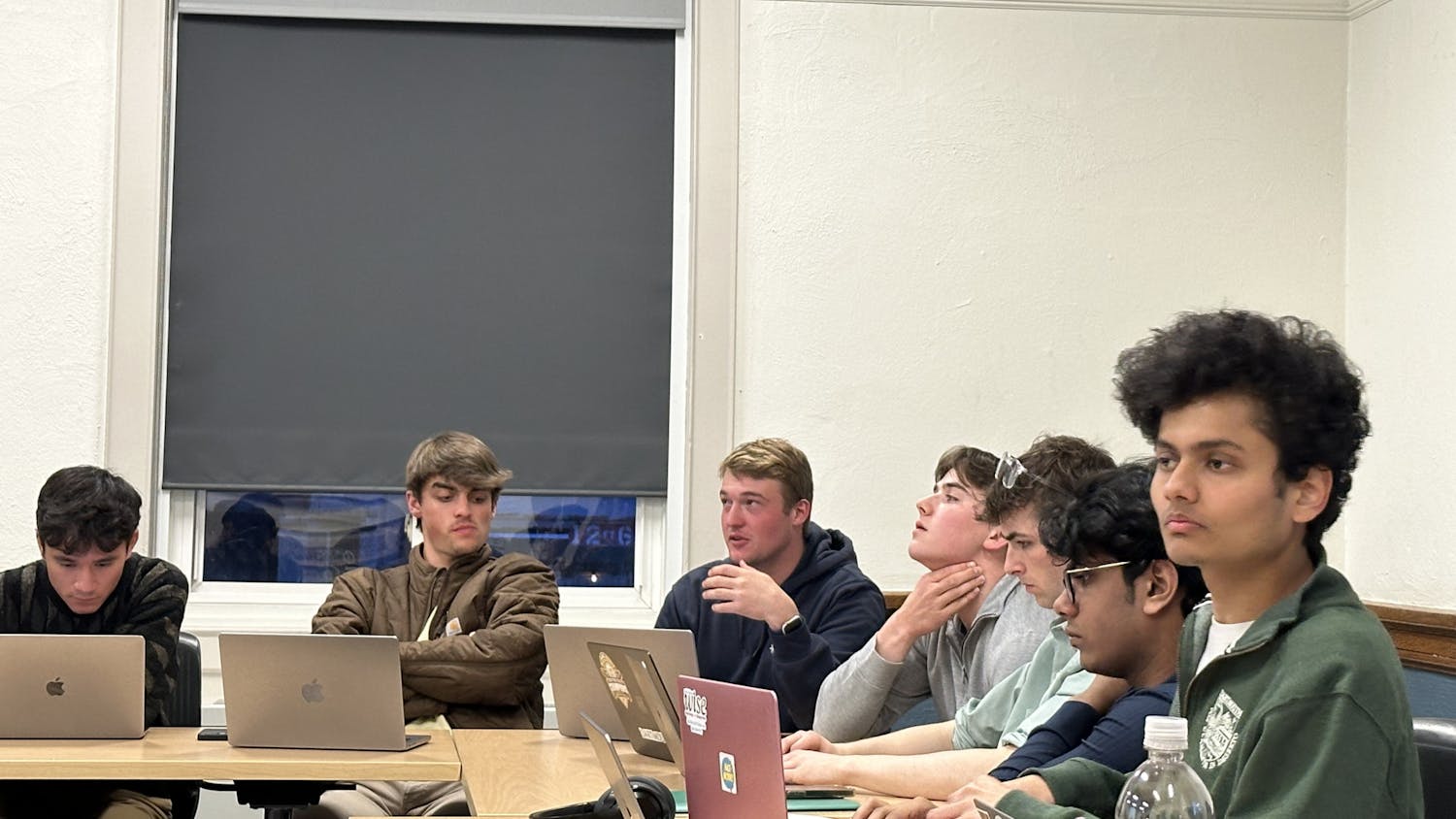In a basketball season marked by parity and scandal, it was only fitting that the NCAA Men’s Basketball Championship was won by a team which made one of the most dominant runs in recent history while led by a clean-cut coach, referring both to his lack of involvement in the most recent benefits scandal and to the fact that he’s always dressed to the nines with his suits.
The Villanova University Wildcats, the 1-seed in the East Region, defeated the University of Michigan Wolverines, the 3-seed in the West Region, 79-62 last Monday. Before taking a look at the game itself, many people, including myself, took part in the time-honored tradition of making a bracket to predict which teams would make the championship game. Many people, including myself, ended up picking the wrong teams. The Final Four this year included 11-seed Loyola University Chicago, 3-seed Michigan, 1-seed University of Kansas and 1-seed Villanova.
According to ESPN.com, the most common Final Four combination picked by those who made brackets were 2-seed Duke University, Villanova, 2-seed University of North Carolina and 1-seed University of Virginia. North Carolina was upset in the Round of 32 by 7-seed Texas A&M University, Duke lost to Kansas in the Elite Eight and Virginia, as most people know by now, was upset by 16-seed University of Maryland, Baltimore County in the Round of 64. I personally picked Villanova, Virginia and Duke to make it, with 4-seed Gonzaga University as the fourth team. Shows how much I know. Among the brackets picked by basketball analysts, 3-seed Michigan State was a popular pick to win the region along with Duke and Kansas, dubbed the Region of Death by most pundits.
Now to the game itself. The contest started off relatively close, but it looked like Michigan was going to pull away early. Six-foot-11-inch, 245-pound junior Moritz Wagner scored nine of the team’s first 11 points. With some key plays by six-foot-four-inch, 190-pound senior Muhammad-Ali Abdur-Rahkman, who would finish as the team’s leading scorer with 23 points and one rebound, Michigan found itself up 21-14 with 11 minutes to go in the first half. This part of the game was marked by poor shooting from both teams, something that is uncharacteristic of Villanova. Villanova was a 40.1 percent three-point shooting team up until this game (11th in the nation), while Michigan was a 35.2 percent three-point shooting team (156th in the nation, right around the national average). With 7:57 to go in the first half, Villanova was one for nine from three (.111) while Michigan was two for eight (.250). Considering that Villanova’s percentage of points that come from three-point shots (40.2 percent) is so high, it looked for a moment like Villanova was going to have an off-night shooting, which would prove disastrous if the Wildcats couldn’t get hot.
Enter Donte DiVincenzo of Villanova. Donte’s Inferno, the Michael Jordan of Delaware, the Big Ragu (his teammates call him that, apparently; I won’t question it) — no matter what you call him, DiVincenzo had a night. DiVincenzo, a six-foot-five-inch, 205-pound sophomore from Newark, Delaware, would finish the night with 31 points, shooting five for eight from two, five for seven from three and six for ten from the free throw line, while adding five rebounds, three assists and two blocks. One would look at this stat line and think, “Huh. That’s really good. I’d expect a Villanova starter to have a great game like that.” Only DiVincenzo came in off the bench. The Big Ragu is a reserve player. On a Villanova team which, before the postseason tournament started, had six players averaging at least 10 points per game, a testament to the team’s shooting prowess and the method by which they rotate players, DiVincenzo was mostly an afterthought. DiVincenzo would most often substitute in for Phil Booth, a junior who led Villanova in scoring when the Wildcats won the National Championship two years ago. Although he would come in off the bench, DiVincenzo gets more playing time than Booth on average (72.5 percent of the team’s minutes compared to 55.9 percent). When looking at the talent that Villanova has on its roster, no one would think of DiVincenzo as the player to put up that kind of dominating performance on college basketball’s biggest stage. Phil Booth led Villanova in scoring in the 2016 championship game; Jalen Brunson won the Naismith Player of the Year Award and a few others; Mikal Bridges is going to the NBA; Omari Spellman was a five-star recruit. Nobody would think of some scrawny kid who played high school basketball in Delaware to be the hero Villanova needed.
But he was. The only other players to score more than 30 points while shooting better than 66 percent on field goals in a Final Four game were Bill Walton (two NCAA championships at UCLA and two NBA titles with the Portland Trailblazers and Boston Celtics) and Kareem Abdul-Jabbar (six NBA titles with the Milwaukee Bucks and Los Angeles Lakers and six-time NBA MVP). That’s some pretty good company.
Let’s get back to the game. After Michigan held its 21-14 lead, DiVincenzo would offer up 12 points and one assist during a 23-7 run, which would give Villanova a nine-point lead at the half. DiVincenzo would remain on the bench for about 50 seconds in the beginning of the second half, then go on to score nine straight points to ruin any hopes for Michigan. DiVincenzo would open this run with an around-the-back dribble to make a layup and get fouled. After shooting his free throws, he ran all the way to the other end of the court to deliver a block on Michigan’s Charles Matthews, which left the ball wedged between the hoop and the backboard. Once the run ended, the score was 62-44 Villanova with 7:57 left, and the Wildcats had a 99.4 percent chance to win the game, per KenPom.com. The rest of the game lacked in excitement for better or worse, as Villanova made most of its points through free throws after Michigan began to play the foul game and closed ahead by 17.
So what does this all mean? We can start by taking a look at how dominant Villanova’s run was throughout the tournament. Villanova’s average margin of victory in all of its tournament games was 17.7 points, and the Wildcats won all of their games by 12 points or more. This is even more impressive considering that Villanova had a relatively chalky run in its region, meaning the Wildcats played some of the best teams during each of their games. The teams that Villanova played, with the appropriate KenPom Adjusted Offensive and Defensive Efficiency rankings in parentheses, are as follows: Villanova (1-22 pre-tourney; 1-11 post-tourney) played 16-seed Radford University (212-127) in the Round of 64, 9-seed University of Alabama (106-20) in the Round of 32, 5-seed University of West Virginia (10-41) in the Sweet Sixteen, 3-seed Texas Tech University (50-4) in the Elite Eight and 1-seed University of Kansas (5-47) in the Final Four. Villanova also led every team it played through the second half of its games, except for West Virginia, where the Wildcats were down 60-54 with 11 minutes to go in the game but pulled ahead to win 90-78. Villanova also joins a selective group as one of only three other programs to win two NCAA titles in three years within the past few decades, joining Duke in 1991 and 1992 (featuring players such as Christian Laettner and Grant Hill), the University of Florida in 2006 and 2007 (featuring players such as Joakim Noah and Al Horford) and the University of Kentucky in 1996 and 1998.
Michigan, while not a bad team by any means (33-8), had a relatively easy road to the championship game. Michigan was the first team in Final Four history to make the Championship game without playing a top-5 seed. Michigan played 14-seed University of Montana, 6-seed University of Houston (under-seeded in my opinion), 7-seed Texas A&M University, 9-seed Florida State University and 11-seed Loyola University Chicago. Michigan certainly earned its way to the championship game; however, Villanova was far and away the best team it played. Many people speak to Villanova as an offensive-minded team, but the Wildcats also play great defense. Villanova ended their tournament run allowing 94.0 points per 100 possessions, so its defense is no pushover. Michigan also shot 3-23 from the three-point line, another testament to Villanova’s defense.
Speaking for the Big Ten as a conference, it had a pretty weak showing in the postseason tournament this year compared to other power conferences. Apart from Michigan, the conference champion, only three other teams earned bids. 2-seed Purdue University lost in the Sweet Sixteen to 3-seed Texas Tech after seven-foot-two-inch, 290-pound Isaac Haas exited with an elbow injury. Three-seed Michigan State University lost to 11-seed Syracuse University in the Round of 32, and 5-seed Ohio State University lost to 4-seed Gonzaga in the Round of 32. Half of the Big Ten’s teams exited in the first weekend of the tournament. To add to that, the Big Ten is now 0-7 in its last seven title game appearances (2018 Michigan, 2015 Wisconsin, 2013 Michigan, 2009 Michigan State, 2007 Ohio State, 2005 Illinois, 2002 Indiana). Its last championship game win was in 2000, when Michigan State beat Florida.
So the players balled out, but how much of the victory can be attributed to Villanova’s coaching? It is important to recognize that Jay Wright, Villanova’s head basketball coach since 2001, used to be seen as one of college basketball’s biggest chokers in the postseason. From 2010 to 2015, excluding 2012 when his team did not make the tournament (Wright’s only losing season at Villanova), Wright’s Wildcats never made it past the Round of 32 in the NCAA Tournament. In 2010, 2014 and 2015, Wright’s team was upset by much lower seeds as well — 10-seed Saint Mary’s University in 2010; 7-seed and eventual national champion University of Connecticut in 2014; 8-seed North Carolina State University in 2015. Although the Wildcats won the national championship in 2016, the very next year, as a 1-seed, Villanova was upset yet again by 8-seed Wisconsin. Regardless of the upsets in the past, the fact that Wright’s teams were able to earn a 1 or 2 seed in each of the past five tournaments, and also won the Big East Conference in each of those years, save 2016-17, is a testament to his consistency. I don’t think Villanova is going away anytime soon. Among the starting five for Villanova this season, along with DiVincenzo, the only two players that are likely leaving are Mikal Bridges and Jalen Brunson. This leaves Villanova’s starting five next year looking like DiVincenzo, Eric Paschall, Phil Booth, Omari Spellman and a five-star recruit in Jahvon Quinerly. That roster looks eerily similar to this year’s. When the 2006 National Champion Florida Gators returned their entire starting five for the next season, they won another national championship. Since Villanova is returning four of their starting five, upgrading a bench player who played more than a starter to a starting role and adding a five-star freshman, this dynasty could continue.
Regardless of how well your bracket did, or your thoughts on the scandal making its rounds through the college basketball world, it’s important to sit back and reflect on what a year it has been for Philadelphia sports. Villanova winning the championship is icing on the cake for Philadelphia after the Eagles won their first Super Bowl in February. Who knows, maybe the 76ers will make it to the NBA finals this year after they’ve trusted the process for so long. It’s been a great season; see you guys next year.



